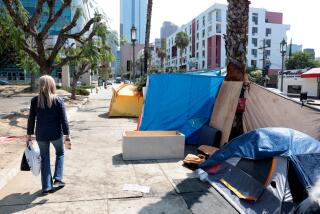Recovery Program Too Tough for Some
Marie, 17, said it was time. She was ready.
She had already gone through the heroin withdrawal that kept her awake for days and made her muscles twitch and her body ache.
She was sick of living like a party girl, after more than five years of smoking marijuana, drinking and shooting heroin.
And she wanted to be a mom to her 23-month-old daughter being raised by Marie’s mother, Ruth.
“This lifestyle gets old,” she said, as she played with her tongue ring. “You lose everything. Your family, your friends, your life.”
So on a warm March morning, Marie, with thick black hair and tattoos on her shoulders, was released from Juvenile Hall into the Rainbow Recovery Youth Center.
The Santa Paula house, Ventura County’s only residential drug treatment program for teens, has six beds for girls. There are no county-funded beds for boys in the county.
Marie was one of the lucky few to get into the Rainbow center. And she hoped four months there would give her the solace and strength she needed to quit.
Her mother, who lives in a comfortable two-story house in Thousand Oaks, was not as confident. The inpatient program doesn’t work for everyone.
And Ruth had already tried so much--checked Marie into rehab hospitals, sent her to a reform school and worked extra hours to pay for programs.
But none of it had worked. Marie kept lying and stealing from her. And she kept getting caught shoplifting and using drugs.
“It’s hard because I’ve been doing this for five years,” Ruth said as her daughter began her latest cleanup effort. “But she’s still my little girl, so what am I going to do?”
On her first day at Rainbow, Marie bit her fingernails as the house rules were explained. They sounded strict, but reasonable. No smoking. No boyfriends. Only calls from parents or sponsors.
As the days passed, Marie quickly fell into the rhythm of the center--she cleaned, exercised, studied, met with a counselor and attended dozens of support groups.
The first big challenge came about three weeks into the program, when she let a boy put his hand on her back during an outside meeting. The night manager, Judy Ulrich, warned her about a possible write-up.
“I’m not a little girl,” Marie snapped.
Despite Marie’s behavior, Rainbow director Traci Lewis still let her have a pass in early April so she could celebrate her daughter’s second birthday. Marie had looked forward to it all week. But when she got home, she dismissed her daughter with a quick hug, then disappeared upstairs to hang out with her girlfriends.
So when Marie’s 2-year-old daughter started crying, it was Ruth who picked her up and held her.
As the day neared its end, Marie made it clear she had no real interest in going back to Rainbow. The rules were restrictive and unnecessary, she complained. She simply didn’t want to be there anymore, she told her mom.
And right then, Ruth knew it was over. Here we go again, she thought to herself.
This time, Marie finally decided to return to Rainbow. But the following weekend, she was back home on another pass. She told Ruth she was going to hang out with a few girlfriends, but instead used heroin with an old boyfriend, her mother said.
That night, Rainbow’s counselors immediately spotted the relapse. Marie admitted it. So a Rainbow staff member called her mom and her probation officer. Rather than risk being sent back to Juvenile Hall, Marie ran away.
Today, more than a month later, Ruth says she doesn’t know where her daughter is. Marie calls every other day to check in, but refuses to come home and says she won’t get help.
When Ruth doesn’t receive a call for a few days, she gets frantic. She worries that the next call will be the police.
“Every time I think there is a glimmer of hope, she shoots it down,” Ruth said. “So I don’t know what it’s going to take.”
More to Read
Sign up for Essential California
The most important California stories and recommendations in your inbox every morning.
You may occasionally receive promotional content from the Los Angeles Times.









